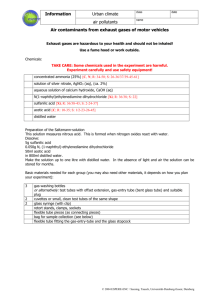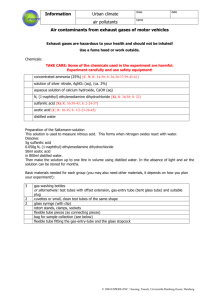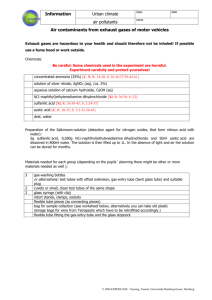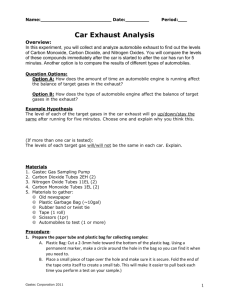T 2
advertisement
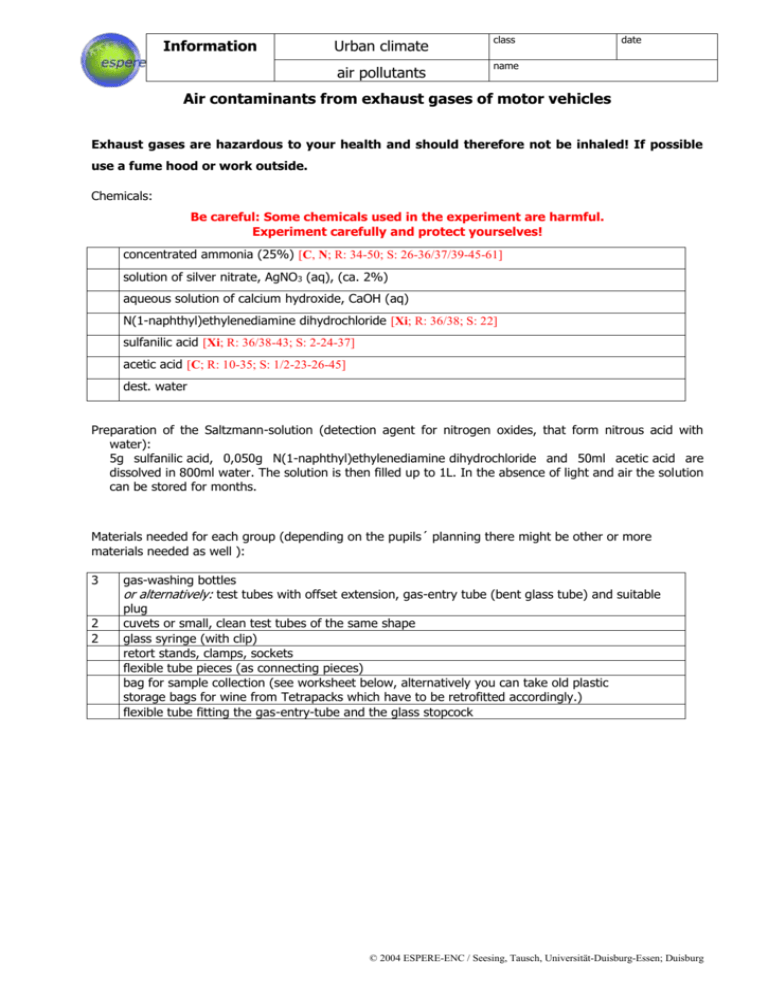
Information Urban climate class air pollutants name date Air contaminants from exhaust gases of motor vehicles Exhaust gases are hazardous to your health and should therefore not be inhaled! If possible use a fume hood or work outside. Chemicals: Be careful: Some chemicals used in the experiment are harmful. Experiment carefully and protect yourselves! concentrated ammonia (25%) [C, N; R: 34-50; S: 26-36/37/39-45-61] solution of silver nitrate, AgNO3 (aq), (ca. 2%) aqueous solution of calcium hydroxide, CaOH (aq) N(1-naphthyl)ethylenediamine dihydrochloride [Xi; R: 36/38; S: 22] sulfanilic acid [Xi; R: 36/38-43; S: 2-24-37] acetic acid [C; R: 10-35; S: 1/2-23-26-45] dest. water Preparation of the Saltzmann-solution (detection agent for nitrogen oxides, that form nitrous acid with water): 5g sulfanilic acid, 0,050g N(1-naphthyl)ethylenediamine dihydrochloride and 50ml acetic acid are dissolved in 800ml water. The solution is then filled up to 1L. In the absence of light and air the solution can be stored for months. Materials needed for each group (depending on the pupils´ planning there might be other or more materials needed as well ): 3 2 2 gas-washing bottles or alternatively: test tubes with offset extension, gas-entry tube (bent glass tube) and suitable plug cuvets or small, clean test tubes of the same shape glass syringe (with clip) retort stands, clamps, sockets flexible tube pieces (as connecting pieces) bag for sample collection (see worksheet below, alternatively you can take old plastic storage bags for wine from Tetrapacks which have to be retrofitted accordingly.) flexible tube fitting the gas-entry-tube and the glass stopcock © 2004 ESPERE-ENC / Seesing, Tausch, Universität-Duisburg-Essen; Duisburg Worksheet No.____a Urban climate class air pollutants name date Air contaminants from exhaust gases of motor vehicles 1. Preparation and sample collection of exhaust gas in freezer bags You need sample collection bags in order to collect and transport your samples of exhaust gas. You can take different kinds of bags but we propose commercial freezer bags (without fastener). Before using them as collection bags they have to be modified as follows: materials needed for each bag: 1 freezer bag (or a thick airtight and gas-impermeable plastic bag) with a volume of 3 to 10 liters 1 tube (glass, plastic or metal) length: 15-30 cm, diameter: 25- 50 mm broad plastic tape 1 rubber stopper (for the connection of the glass stopcock with the glass tube, see pictures 1-4) 1 glass stopcock (or glass tube with rubber hose and pinchcock) picture 2 picture 1 picture 3 picture 4 The glass tube should be placed at the middle of the open side of the plastic bag and should reach far into the bag. In order to seal the bag, apply tape first to the sides of the bag, wrap the sides around the glass tube and tape again tightly (see pictures 1-4 above). Taking the sample: Try to avoid inhaling the exhaust gases! You can usually take the sample by removing the stopper, wrapping the end of the glass tube with a piece of cloth, removing all air inside the bag, placing the glass tube tightly at the end of the exhaust pipe (see picture no. 5). “Wash” the bag once with exhaust gas before taking the actual sample. As soon as the bag is filled with gas for a second time attach the stopper to the glass tube, c.f. picture no. 4 (after having closed the pinchcock). If the procedure decribed above is not possible proceed as follows: Take a glass tube and attach a cork stopper to one end. The stopper should also fit the vent of the exhaust pipe. The other end of the glass tube is connected to the glass tube of the collecting device via a rubber hose (see picture no. 6). For this alternative a greater gas pressure is needed. Therefore it is necessary to close all vents which are connected to the vent where the sample is taken with cork stoppers. If you vary the immersion depth of the stopper (arrow in picture no.6) you can change the gas pressure so the motor keeps running. Make a sample collection bag for each sample you plan to take. T1 T2 picture 6 Take your samples, number each of them and match them with the criteria of table no.1: (The samples should be analysed at the same day.) Table 1 petrol engine picture 5 4 stroke without exhaust catalyst cold motor motor at operating temperature sample no.1 sample no.2 Yamaha XZ550 Yamaha XZ550 cold motor with exhaust catalyst motor at operating temperature sample no.3 Audi 100 2 stroke diesel engine 4 stroke sample no.4 VW Golf II 1.6l sample no.5 VW Golf II 1.6l (2 stroke) © 2004 ESPERE-ENC / Seesing, Tausch, Universität-Duisburg-Essen; Duisburg Worksheet No.____b Urban climate class air pollutants name date Air contaminants from exhaust gases of motor vehicles 2. Qualitative analysis of exhaust gas (CO, CO 2 und NOx) T3 Complete the information below by adding the missing reaction schemes! Information on the identifications: 1. Identification of carbon monoxide with an ammoniac solution of silver nitrate: Properties of carbon monoxide: solubility in water 0,23g/L (20°C), bp: -191°C, reducing agent, highly toxic in concentrations w>5%, MAK: 30ppm Reaction scheme for this identification: 2 [Ag (NH3)2]+(aq) + 2 H2O(l) + CO(aq) 2 Ag(s) + 4 NH4+(aq) + CO32-(aq) 2. Identification of carbon dioxide with lime water (aqueous solution of calcium hydroxide): Properties of carbon dioxide: solubility in water 1,78g/L (20°C), subl.: -79°C, MAK: 5000ppm Reaction scheme for this identification: Ca(OH)2 (aq) + CO2 (aq) CaCO3 (s) + H2O(l) 3. Identification of nitrogen oxides with Saltzmann solution: Properties of nitrogen dioxide: reacts with water yielding HNO 2 and HNO3, bp:21°C, vapour pressure: 1013hPa at 20°C, highly toxic in concentrations w>1%, MAK: 5ppm Reaction scheme for this identification: Exhaust gases contain substances that are hazardous to your health: When carrying out the experiments use a fume hood or work outside ! T4 Plan an experimental set-up and a procedure that meets the following criteria: 1. Each exhaust gas sample should be simultanuously tested for carbon monoxide, carbon dioxide and nitrogen oxides. 2. The identification should be arranged in an order in which they do not falsify of interfere with each other. (Take into consideration the different solubilities, reactivities with water and reaction products.) 3. A semi-quanitative differentiation of the concentration of the pollutants in the different exhaust gas samples should be made by controlling the volume of the tested exhaust gases. Order of identification: 1. Identification of nitrite with ca. 2-3mL Salztmann solution: nitrogen dioxide reacts with water and is easily washed away from the exhaust gases. 2. Identification of carbon dioxide with ca. 2-3mL aqueous solution of calcium hydroxide: the solubility of carbon dioxide is also relatively good, but the amount of carbon dioxide is high enough to do this identification secondly. 3. Identification of carbon monoxide with ammoniacal (ca. 0,5mL concentrated ammonia) silver nitrate solution (ca. 2mL of a 2% solution): The solubility of carbon monoxide in water is relatively poor. A product of this identification is carbon dioxide. Therefore the identification of carbon dioxide has to be carried out before (see step 2). The sensitivity of the proofs is enhanced due to the relatively little volume of the examined solution. © 2004 ESPERE-ENC / Seesing, Tausch, Universität-Duisburg-Essen; Duisburg a: sample collection bag b: Saltzmann- solution c: aqueous solution of calcium hydroxide d: ammoniacal solution of silver nitrate, AgNO 3 (aq) e: threeway valve for sucking in the combustion gases and for emptying the glass syringe f: glass syringe for sucking in the combustion gases and measuring the gas volume Man sauge etwa 200-600mL Abgas langsam durch die Apparatur. (der Nitritnachweis © 2004 Seesing, benötigt etwasTausch, Zeit.)Universität Duisburg-Essen, Duisburg As approximate volume take the volume needed to get a positive result for all three proofs in a gas sample taken from a cold 4 stroke engine without catalyst. (For the examples below 400 mL were used.) [If you want to do more than one measurement in the same apparatus make sure you thoroughly clean and dry section “b“.] The fact that the identifications do not interfere with each other can be proved by blowing the pure pollutants through the apparatus. There are three short clips showing this: 1. Identification of nitrite with Saltzmann solution: Clip 1 (198kB). Here the nitrogen oxides are produced by the reaction of copper with concentrated nitric acid. 2. Identification of carbon dioxide with an aqueous solution of calcium hydroxide: Clip 2 (212kB). The carbon dioxide of the exhaled gas of human beings is used here (instead of pure carbon dioxide, but the result is the same). 3. Identification of carbon monoxide with an ammoniacal solution of silver nitrate: Clip 3 (452kB) The carbon monoxide is gained by drop by drop adding formic acid to a hot (70-80°C) concentrated sulfuric acid. [The additional first reaction tube is used for cleaning the gaseous carbon monoxide, it is filled with water.] T5 Analyse your exhaust gas samples and list your results in the table below. sample no. CO CO2 NOx as NO 1 2 3 4 5 a lot a little less hardly detectable a lot less a lot a lot a lot a lot a lot a little less a lot little a great amount a great amount © 2004 ESPERE-ENC / Seesing, Tausch, Universität-Duisburg-Essen; Duisburg
